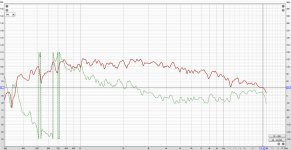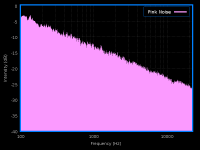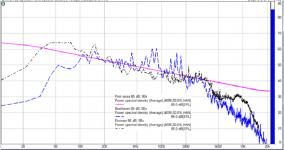Hello, I am searching for an amp to power the said driver which in combination with the horn I'm using, sensitivity is somewhere around 112 to 114 Db
In a previously completely unrelated thread I learned about amps that might work for high sensitivity drivers in general...this completely different and unique thread is different from the previous thread. I am looking for an amplifier that will work specifically for the axi2050, in this thread, unlike the broad approach of my previous thread about amps for high efficiency drivers.
Ive never built an amp before...if I choose a build maybe I can get you guys to hold my hand?
My aim was for class a with neutral/transparent playback...no harmonic distortion commonly associated with some tube designs please
In a previously completely unrelated thread I learned about amps that might work for high sensitivity drivers in general...this completely different and unique thread is different from the previous thread. I am looking for an amplifier that will work specifically for the axi2050, in this thread, unlike the broad approach of my previous thread about amps for high efficiency drivers.
Ive never built an amp before...if I choose a build maybe I can get you guys to hold my hand?
My aim was for class a with neutral/transparent playback...no harmonic distortion commonly associated with some tube designs please
Last edited:
The quality that you need most is called monotonicity. This means that all effects decrease without any pauses or hiccups in the curve as signal level decreases. Although often ignored, especially commercially, this is the secret sauce of all good amplifier design, but is especially important for your application.
Speaker sensitivity North of 110dB SPL/1W/1M means that the amplifier will be operating at peak outputs at party levels of less than a Watt, and needs to be clean at -40dB of that (.0001W) and have no crossover distortion effects to below -70dBW (1nW).
At these levels, a small valve amplifier with a triode output is the usual recommendation. Maybe a variation of Stephe's miniature amplifier with the output stage strapped for triode, or maybe just try it as is. It's well documented and would fit the bill.
6BM8 "tiny tube amp" build + Video Series
All good fortune,
Chris
Speaker sensitivity North of 110dB SPL/1W/1M means that the amplifier will be operating at peak outputs at party levels of less than a Watt, and needs to be clean at -40dB of that (.0001W) and have no crossover distortion effects to below -70dBW (1nW).
At these levels, a small valve amplifier with a triode output is the usual recommendation. Maybe a variation of Stephe's miniature amplifier with the output stage strapped for triode, or maybe just try it as is. It's well documented and would fit the bill.
6BM8 "tiny tube amp" build + Video Series
All good fortune,
Chris
Last edited:
Not a big challenge, but at that point, you might want to consider a two stage push pull amplifier and gain its advantages. A differential input stage of twin triode with a current source, feeding push-pull small triodes, really wouldn't need any feedback or tricks or treats. But that's a horse of a different flavor.
If you don't mind an extra $200US you could do the balancing with a pair of Jensen, or other quality transformers. Good ones have advantages that can't be had any other way, and will last a lifetime in future amp builds. Just a thought.
All good fortune,
Chris
If you don't mind an extra $200US you could do the balancing with a pair of Jensen, or other quality transformers. Good ones have advantages that can't be had any other way, and will last a lifetime in future amp builds. Just a thought.
All good fortune,
Chris
I don't follow what you mean by "at this point"...I took a look at the "6BM8 "tiny tube amp" build...It looks doable and affordable...in regards to high efficiency drivers it seems that some suggest a class A mosfet type amp
Alpha Nirvana 39w 8ohm Class A Amp
Babelfish M25 R.2/SET amp kit packages
Are two paths I am entertaining...You stated clearly that "monotonicity" was the trait I was looking for and the amp you suggested (6BM8) has this trait (otherwise you wouldn't of suggested it right?) and if I can simply add balanced inputs using a Jensen transformer as you say....then the only con I can think of is having to replace tubes? I dunno how that works exactly...
Alpha Nirvana 39w 8ohm Class A Amp
Babelfish M25 R.2/SET amp kit packages
Are two paths I am entertaining...You stated clearly that "monotonicity" was the trait I was looking for and the amp you suggested (6BM8) has this trait (otherwise you wouldn't of suggested it right?) and if I can simply add balanced inputs using a Jensen transformer as you say....then the only con I can think of is having to replace tubes? I dunno how that works exactly...
Sorry for not being more clear. I'd meant to suggest two different alternatives, a dedicated push pull amplifier with diff inputs, or a conventional amplifier with single-ended inputs and an input transformer grafted onto the front end. The second could be a 6BM8 tiny tube, or pretty much anything. The first would require so much redesign of the 6BM8tt that you might as well start fresh, and take advantage of an all push pull amplifier's power supply immunity, lower distortion, etc.
Just discovered that diyaudio has a wiki section. Here's an excellent example of the possibilities of push pull, and in a design with massive, multi-year support on diyaudio (which is even more valuable when getting started than any fancy schmancy design) and optional differential input:
Baby Huey PP EL84 amplifier
All good fortune,
Chris
Just discovered that diyaudio has a wiki section. Here's an excellent example of the possibilities of push pull, and in a design with massive, multi-year support on diyaudio (which is even more valuable when getting started than any fancy schmancy design) and optional differential input:
Baby Huey PP EL84 amplifier
All good fortune,
Chris
I just did some digging and it seems like single end is what I am looking for....1-5 watts is likely the target. I have no idea of how rms vs max watts works for this...I read that SE does not cancel out 2nd order harmonics of the original signal and was like yep. 6BM8TT sounds like a good starting point...what do you suggest I do?
My suggestions can only be within the range of things that appeal to me. Of course. If the 6BM8TT appeals to you, that would be an excellent place to start. Single-ended Class A amplifiers of all kinds are inherently monotonic, and the level of difficulty seems manageable but rewarding for a first build. This isn't going on an Apollo mission, so it doesn't have to be a life or death decision. It can be fun - but safety, safety, safety.
For your use, I'd make a few adjustments to the original: first, a much larger chassis. Start with a Bud or Hammond aluminum chassis with its bottom cover, 3" depth (chassis height).
Almost the bigger the better - maybe nothing smaller than 10" x 14", and you'll wish it were 14 x 17 unless you're very young and nimble of hand and eye.
Second, you might want to include a second stage of power supply filtering, another choke plus capacitor. You're in the bleeding edge of speaker sensitivity, and parts are cheap.
Third, include a Zobel (a snubber) across the output terminals, a series R of 10R/2W and C of 0u1F/63V. For damping of ringing and stability with unpredictable (or missing) loads.
Do you have a good way to make some holes in an aluminum chassis?
All good fortune,
Chris
For your use, I'd make a few adjustments to the original: first, a much larger chassis. Start with a Bud or Hammond aluminum chassis with its bottom cover, 3" depth (chassis height).
Almost the bigger the better - maybe nothing smaller than 10" x 14", and you'll wish it were 14 x 17 unless you're very young and nimble of hand and eye.
Second, you might want to include a second stage of power supply filtering, another choke plus capacitor. You're in the bleeding edge of speaker sensitivity, and parts are cheap.
Third, include a Zobel (a snubber) across the output terminals, a series R of 10R/2W and C of 0u1F/63V. For damping of ringing and stability with unpredictable (or missing) loads.
Do you have a good way to make some holes in an aluminum chassis?
All good fortune,
Chris
Tiny tube amp may be where I land unless theres something better...I dont know/understand amplifiers like you guys but I think the thd percentage is all I need keep in check to keep tubes from "coloring" the sound... I seen the pictures showing the thd characteristics
for the tiny tube amp and got scared because I don't want anything coloring my sound...
Do tube amps entertain rms and max power?
I was thinking mosfet for the mid and class d for the subs
Does this sound logical?
for the tiny tube amp and got scared because I don't want anything coloring my sound...
Do tube amps entertain rms and max power?
I was thinking mosfet for the mid and class d for the subs
Does this sound logical?
Last edited:
Peak power output, as long as it's adequate, and distortion measurements near peak output, are almost unimportant for actual audio amplifier use. Do you really care about performance at 120dB SPL in your home? If so, ignore everything I've ever said. If not, then your design criteria would include performance at actual signal levels.
What is an actual working level for an audio amplifier? Mastering room reference level is 85dB SPL average (VU meter style average) at listening position. This is *very* loud, and is endured in order to hear mistakes both musical and technical. Professional headroom of 20dB means peak mastering levels of 105dB SPL, the classic number for a full sized symphony orchestra 10th row center.
The audio amplifier must be capable of reproducing the 105dB SPL peaks, plus some margin, at a reasonable but not necessarily stringent distortion spec, but also to reproduce the body of the music, at 85dB SPL and below, without noticeable distortion. Whatever distortion it adds must decrease monotonically down to way below the noise floor. A good amplifier will not add to the noise floor, so room noise will dominate. A quiet domestic room with HVAC might get down to 25dB SPL if you're wealthy, 40dB SPL if you're not. Because our hearing works a good 20dB below the noise floor (see: critical bands), distortion must be monotonic to the equivalent of 5dB SPL to 20dB SPL.
So, at what level would distortion criteria actually matter? Assuming the worst case of mastering room levels (way, way, too loud for me, but) two speakers adding non-coherently add to +3dB, each speaker is (say for example) 112dB SPL/1W/1M, so 1W per speaker adds to 115dB SPL nearfield. Farfield is room specific, so let's call it 10dB room loss. 1W per amplifier/speaker makes 105dB SPL at listening position. This is our peak output required at worst case (mastering room loudness) conditions.
But what we care about is amplifier performance at levels where the music lies, say, 40dB to 80dB SPL (and much much lower). These translate to from -45dBW (.00003 W) to -5dBW (about 0.3 W). This region's distortion figures actually matter, and must decrease with level monotonically.
But they've historically been harder to measure, because spectral analysis was historically too expensive. So we've looked for our lost wallets under the streetlamp, and often still do because the light is better.
All good fortune,
Chris
What is an actual working level for an audio amplifier? Mastering room reference level is 85dB SPL average (VU meter style average) at listening position. This is *very* loud, and is endured in order to hear mistakes both musical and technical. Professional headroom of 20dB means peak mastering levels of 105dB SPL, the classic number for a full sized symphony orchestra 10th row center.
The audio amplifier must be capable of reproducing the 105dB SPL peaks, plus some margin, at a reasonable but not necessarily stringent distortion spec, but also to reproduce the body of the music, at 85dB SPL and below, without noticeable distortion. Whatever distortion it adds must decrease monotonically down to way below the noise floor. A good amplifier will not add to the noise floor, so room noise will dominate. A quiet domestic room with HVAC might get down to 25dB SPL if you're wealthy, 40dB SPL if you're not. Because our hearing works a good 20dB below the noise floor (see: critical bands), distortion must be monotonic to the equivalent of 5dB SPL to 20dB SPL.
So, at what level would distortion criteria actually matter? Assuming the worst case of mastering room levels (way, way, too loud for me, but) two speakers adding non-coherently add to +3dB, each speaker is (say for example) 112dB SPL/1W/1M, so 1W per speaker adds to 115dB SPL nearfield. Farfield is room specific, so let's call it 10dB room loss. 1W per amplifier/speaker makes 105dB SPL at listening position. This is our peak output required at worst case (mastering room loudness) conditions.
But what we care about is amplifier performance at levels where the music lies, say, 40dB to 80dB SPL (and much much lower). These translate to from -45dBW (.00003 W) to -5dBW (about 0.3 W). This region's distortion figures actually matter, and must decrease with level monotonically.
But they've historically been harder to measure, because spectral analysis was historically too expensive. So we've looked for our lost wallets under the streetlamp, and often still do because the light is better.
All good fortune,
Chris
You are really helping me bring clarity to my situation. I really appreciate your help!
If I boost the HF slope to neutral (vs cutting it to nuetral) I can use a lower powered amp....with a sine sweep or white noise thd will have a rising slope...but with music it will not have such an issue...or rather....with the THD character of the amp (after neutral voicing) with pink noise, is much more important.
I'm sorry, I'm having at least 3 conversation about the same thing...I forgot to show you my 1 watt 1 meter measurement
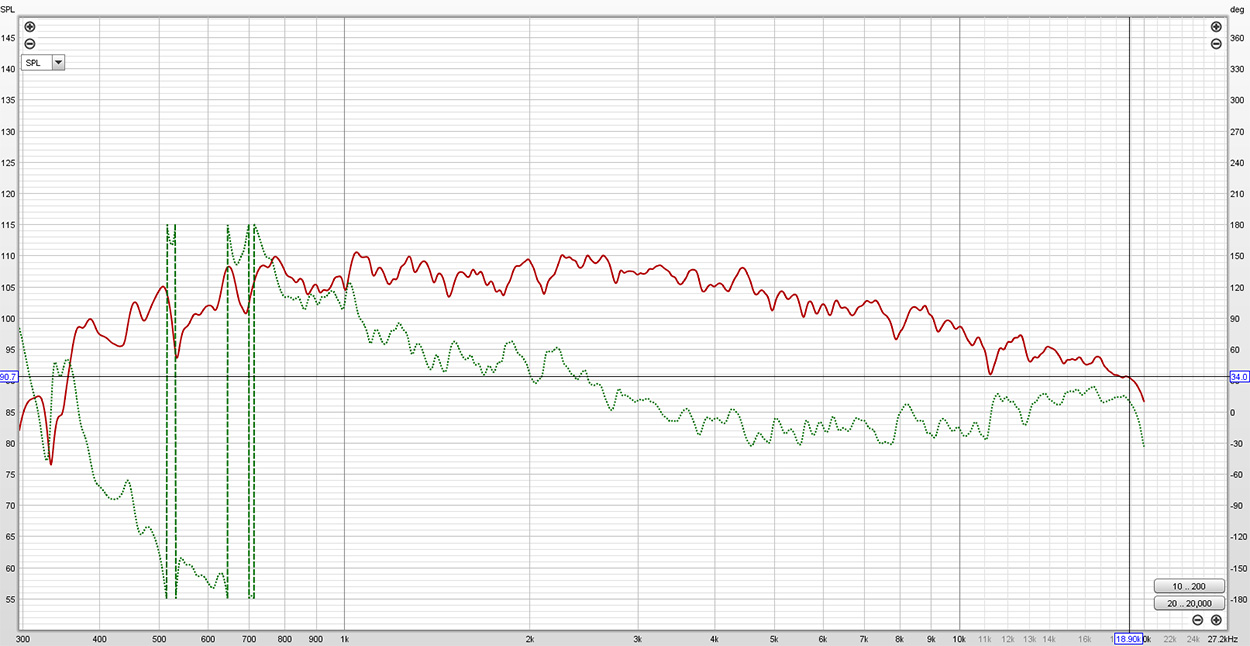
so looking at pink noise, a system spl of 115db will result in a peak of 115db in the bass roll of 3db per octave as we move up....somewhere around -27db at 19.khz.... 88db around 19khz and add 20 for headroom so 108db is needed at the top. This is me trying to apply my philosophy of trying achieve my desired SQ goals at max volume btw....You are approaching this from a much more practical standpoint ie, what happens at actual playback levels
If I boost the HF slope to neutral (vs cutting it to nuetral) I can use a lower powered amp....with a sine sweep or white noise thd will have a rising slope...but with music it will not have such an issue...or rather....with the THD character of the amp (after neutral voicing) with pink noise, is much more important.
- Depending on how much boost I add...right?A good amplifier will not add to the noise floor, so room noise will dominate
- Pink Noise...And then add 20db for headroom was my first thoughtBut what we care about is amplifier performance at levels where the music lies,
I'm sorry, I'm having at least 3 conversation about the same thing...I forgot to show you my 1 watt 1 meter measurement
so looking at pink noise, a system spl of 115db will result in a peak of 115db in the bass roll of 3db per octave as we move up....somewhere around -27db at 19.khz.... 88db around 19khz and add 20 for headroom so 108db is needed at the top. This is me trying to apply my philosophy of trying achieve my desired SQ goals at max volume btw....You are approaching this from a much more practical standpoint ie, what happens at actual playback levels
Attachments
Last edited:
I think if we say 85db playback....a peak sits in bass region at 85db?
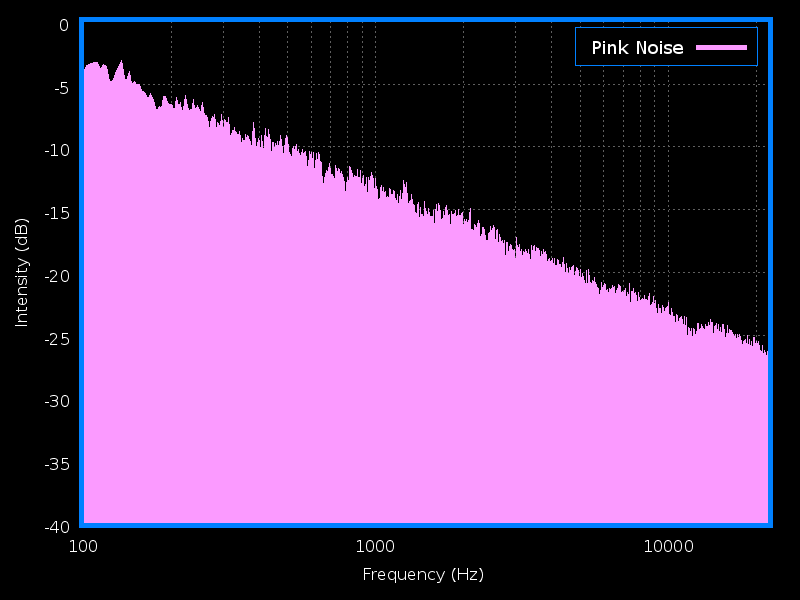
So by 19khz I'd be down the -27db that I stated above....giving me 60db plus 20db of headroom there...So in application (near field) that would really relax my amp requirements power wise....I kinda wanted to design the system to be able to handle far field in the case I ever wanted to use it that way is all. Starting off small and settling in with near field isn't a terrible idea...as I learn, if I ever want Fairfield I can invest in that amp later, and have more knowledge to make choices as well...Aiming for quality at my max system goal (115db@1m) puts into far field spl levels, like I said above, its been my approach so far to the design.
I think at this point, I can dial back my amp game to what you've said above, but first you should probably see the 1 watt 1 meter FR above and consider that I am aiming for neutral voicing.
I just seen this
So by 19khz I'd be down the -27db that I stated above....giving me 60db plus 20db of headroom there...So in application (near field) that would really relax my amp requirements power wise....I kinda wanted to design the system to be able to handle far field in the case I ever wanted to use it that way is all. Starting off small and settling in with near field isn't a terrible idea...as I learn, if I ever want Fairfield I can invest in that amp later, and have more knowledge to make choices as well...Aiming for quality at my max system goal (115db@1m) puts into far field spl levels, like I said above, its been my approach so far to the design.
Oh yeah, Ive been designing towards max spl goals using one channel also (purposely)....two speakers adding non-coherently add to +3dB, each speaker is (say for example) 112dB SPL/1W/1M
I think at this point, I can dial back my amp game to what you've said above, but first you should probably see the 1 watt 1 meter FR above and consider that I am aiming for neutral voicing.
I just seen this
I need to see where the bass spl sits with pink noise in a 85db average measurement85dB SPL average (VU meter style average)
Attachments
Last edited:
I just deleted a long post on accident =(
TLDR: Pink noise reflects a neutral response to the ear reflective of music. Playing pink noise at 85db average spl will show desired spl per frequency. The noise floor of the dsp is in question at this point. "THD+N <0.002%" is rating of the Focusrite sound card I intend to use...using boost to the voice driver neutral , here, should be safe enough. Expecting about 10db of boost in top most range (see first graph for 1w1m measurement)...As long as I am right, I should be able to pull this of with a rather small amp. Looking at this here

suggest that 20khz is about 34db with 85db average pink noise...add 20db for headroom, you get 54db at 20khz. Basically just add 20db to the pink noise slope for headroom. I'll test this out tomorrow possibly and monitor voltage at the level and with voicing so I can see how many watts I end up with.
TLDR: Pink noise reflects a neutral response to the ear reflective of music. Playing pink noise at 85db average spl will show desired spl per frequency. The noise floor of the dsp is in question at this point. "THD+N <0.002%" is rating of the Focusrite sound card I intend to use...using boost to the voice driver neutral , here, should be safe enough. Expecting about 10db of boost in top most range (see first graph for 1w1m measurement)...As long as I am right, I should be able to pull this of with a rather small amp. Looking at this here
suggest that 20khz is about 34db with 85db average pink noise...add 20db for headroom, you get 54db at 20khz. Basically just add 20db to the pink noise slope for headroom. I'll test this out tomorrow possibly and monitor voltage at the level and with voicing so I can see how many watts I end up with.
Attachments
- Home
- Amplifiers
- Tubes / Valves
- Amp for Axi2050
